Wine is masculine for me, grammatically this is also correct. It is called: the wine. But now I met a lady, and she is - like many wines - not male at all. But I didn't immediately recognize her as a lady either: la Petite Arvine, the little Arvine. A wine out of a grape variety that is (almost) only cultivated in Switzerland, namely in Valais. A so-called autochthonous vine.
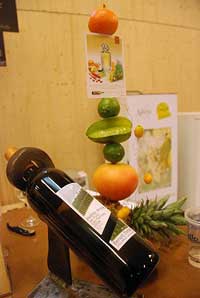 |
| La Petite Arvine - which reminds of exotic fruits in its aromas |
Not even the "big Brockhaus" gives information where the name comes from and which ancestors the variety can show. Sauvignon, as one still often reads, is wrong. But what is right? Even the wine-plus glossary, which I value, doesn't know much more than that "the name possibly refers to the fact that the vine supposedly once reached Switzerland via the Savoyard Arve Valley." Maybe. The fact is that the vine was once almost forgotten, but is now one of the wine jewels of Valais, Switzerland's largest wine canton.
And I, who am often called a "professional Swiss" in German wine circles, have hardly noticed this "jewel" until today. Ignorance? Maybe a little bit, but maybe also an expression of a general respect for all the many autochthonous wines that are still grown in Valais today and are also marketed quite well: Petite Arvine, Cornalin, Amigne, Humagne blanche, Heida, Humagne rouge, Marsanne blanche (Ermitage), Himbertscha, Lafnetscha and what they are all called. There are more than 60 varieties in the Valais, and that is enormous.
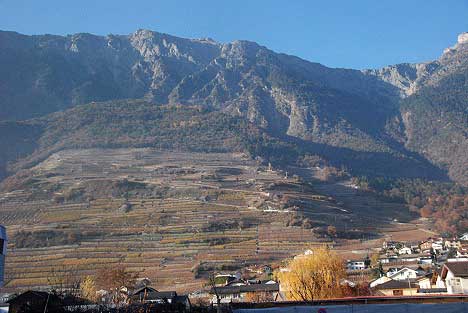 |
| The vineyard area around Fully in the Lower Valais% the home of the "Petite Arvine" |
Petite Arvine is only one of them, in my opinion the best. But that is a matter of opinion! My assertion is strengthened by a visit to Fully, the "capital of the Arvine" (and of the chestnut). Fully? A commune in the Lower Valais, made up of seven villages and with a population of around 6000. Here, every second year, the festival "Arvine en Capitales" takes place, where about 20 producers from Fully present their "Petite Arvine". That's where I recently "ended up" - more or less by chance - in a sober new multi-purpose hall, where the tasting took place. Unfortunately, I didn't experience anything of the festival itself, of all the conviviality and tradition.
But of the wine, of the lady "la Petite Arvine". A look at the small windows high above reminded me again and again that this tasting didn't take place just anywhere, but in the middle of the homeland of the Petite Arvine, there, where - according to tourist advertising - "you can still be surprised by nature."
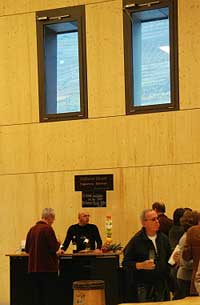 |
| A tasting in the middle of the vineyard% where the Kleine Arvine grows. |
And which of the many "ladies" was the most beautiful, the noblest, the most generous, the most gracious? Hard to say, because I couldn't possibly visit them all; I had to make a "selection". Thank God my two friends knew each other better, so I had time to concentrate on five or six lovely Arvines. What do I read, "A girl of the sun and wind with golden brown skin, she lives wild and grows on the surface of the rock." And not far from that, "Petite Arvine is racy and masculine, putting the soul in a festive mood with its floral and fruity taste."
So is it feminine or masculine? Now I want to know. Only my palate can give me reliable information. I decide to test two still very young ladies of the winemaker Benoît Dorsaz. They seemed to me - very subjectively - the most beautiful, the best, the most trustworthy. Don't ask me why. They were simply, for me, the best two wines I tasted in this setting.
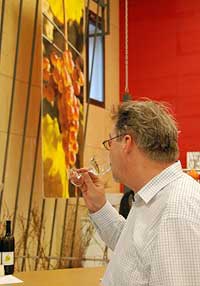 |
| Critical review - what can be said about the Kleine Arvine? |
Benoît Dorsaz farms 5 hectares of vines in different parcels (as is common in the Valais) and presents here two dry-grown wines: Petite Arvine Les Perches (Stangen), 2008, and Petite Arvine Quintessence, 2007. And as it is when you meet a delightful lady - the right words are missing: aromatic bouquet of ripe quinces, bananas, floral with lime blossoms, grapefruit, wisteria, citrus fruits, richness of aromas, melting, fresh, lively acidity... No, not a show-off, a fine lady who actually has masculine qualities, like power, salty notes, also something mineral, stony, yes rocky....
No, I'll stick with it, it's a lady, the little Arvine; I forget that wine is actually masculine for me after all, and think of the peculiarity of the Valais people, who almost made a "national saint" out of a famous 19th century forger - who loved freedom and ladies above all else. Farinet, the Robin Hood of the Alps.
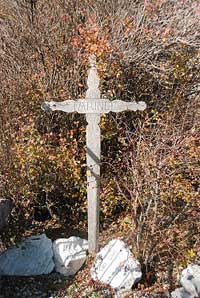 |
| Here lies Farinet buried - the Robin Hood of the Alps. In the middle of the home of the Little Arvine. |
We stood at his grave just before the ladies visited Fully, a few miles to the east, in Sailon. Here he was buried in "unconsecrated ground" in 1880, where murderers are usually buried. 100 years later he has been rehabilitated, chosen as a symbolic figure for the independent Valais. There is something anarchic about this Farinet, as the writer Charles Ferdinand Ramuz described him. "He is a seducer, one who does not like to recognize borders, who, looking at the mountains, exclaims: "But what is freedom? ... Freedom is: to do what one wants, how one wants, when one feels like it." Farinet, after whom the world's smallest vineyard registered in the official wine cadastre (only 3 vines) is also named, goes so well with the graceful Arvine. It seems to me that Farinet and Arvine together welcome all those who seek the distinctiveness of Valais wines.
Sincerely
Yours sincerely